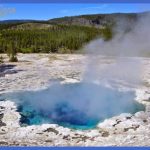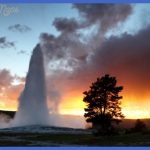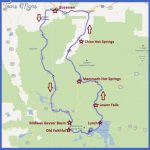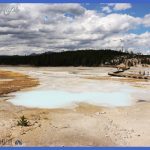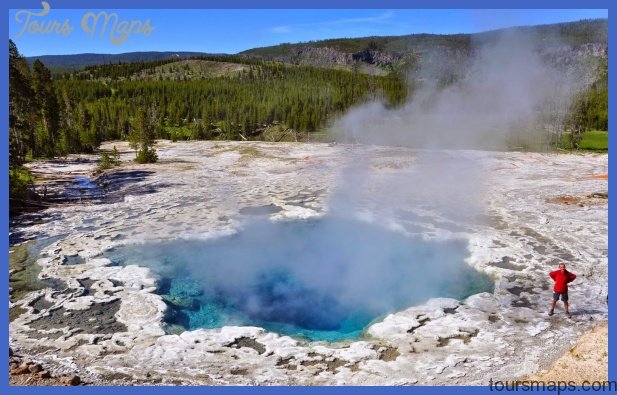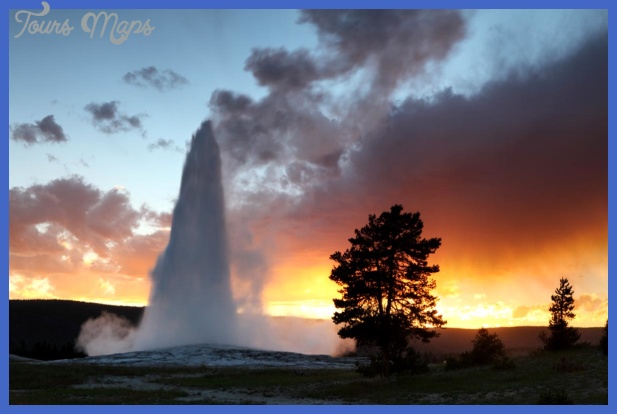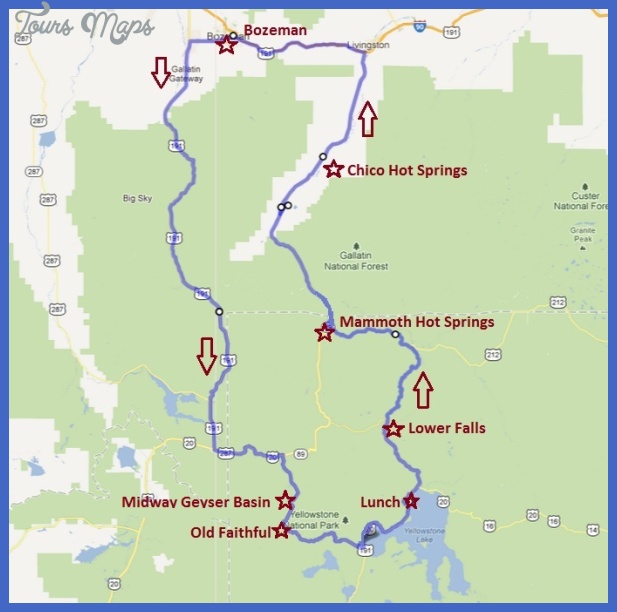NOTE: This is an approved bicycle route to the Grand Loop Road near Biscuit Basin about 2.5 miles (4 km) to the north. To reach Biscuit Basin, turn left on the northern trail to the Daisy Group, then turn immediately right (see the map, 83). C @ The 2.4 miles (4 km) round trip to view Castle and Daisy geysers on Geyser Route Two is paved and can be traversed by wheelchair or bicycle. You may shorten the distance a little by parking in the lot for the general store near Old Faithful Inn. The side trail past Daisy Geyser to Punch Bowl Spring and Black Sand Pool (not fully paved and not open to bicycling) can add another mile (1.6 km) to this excursion. From the visitor center, follow the former main road past the east wing of Old Faithful Inn, keeping Old Faithful Geyser on your right. After passing the inn’s parking area and the side trail to Chinese Spring, you’ll see a large meadow on your right, where bison and elk can find grass even in winter due to warming from hot springs.
West of the store and service station, you may see steam surprisingly close to the buildings. The steam comes from the Myriad Group, where hundreds of hot springs have been counted, including at least one historically interesting feature. Round Geyser erupted as high as 150 feet (46 m) in a few widely spaced years, with long dormancies in between. It rivaled the height of Old Faithful itself. There’s no public access to the area. Castle Geyser is the first thermal feature you come to about a half mile (0.8 km) from the visitor center. This cone-type geyser erupts from the center of a large geyserite edifice that looks very much like a crenelated medieval castle. Castle’s cone is about 12 feet (4 m) high and 6 feet (2 m) in diameter. Major eruptions usually occur about every 13 hours but with longer intervals after minor eruptions. Castle Geyser is Yellowstone’s largest regularly erupting cone-type geyser. sively for 15 to 20 minutes in its water phase, spouting to as high as 100 feet (30 m). Then 30 to 45 minutes of steam phase follow, accompanied by a thrilling roar. Castle is changeable and has displayed other types of eruption patterns in the past. It’s also hundreds if not thousands of years old. A hot spring predating the geyser probably built up its mound of geyserite, and the cone’s lower shelf dates from about AD 1100. Castle’s Neighbors Toward the River Tortoise Shell Spring boils violently in its geyserite cone. It’s one of the hottest springs in the park 207°F (97°C) or hotter and seems to have no connection with neighboring Castle Geyser.
According to some close observers, you can visualize not just the shell but the head, tail, and legs of a tortoise in the spring’s shape. Campers in the early days used this superheated spring to boil their food. Crested Pool is 42 feet (13 m) deep and sometimes boils as high as 10 feet (3 m). According to one of the first guidebook writers, Harry J. Norton (1873): For delicacy of coloring and beauty of ornamentation it surpasses any we visited. It is more quiet than others, yet its surface is gently rippled by constant vibrations. . . . Crested Pool has an almost perfectly symmetrical ten-sided rim. Sad to relate, in 1970 a nine-year-old boy was scalded to death in a few seconds in the superheated water of this pool. The guardrail here and additional warnings of danger throughout the geyser basins were erected in response to the tragedy. Old names for Crested Pool, such as Fire Basin and Devil’s Well, may have been apt after all.
Back on the main walkway Across the pavement from Castle is a fenced hot spring called Shield Pool for its shape. Leaving Castle and continuing on the paved trail, you’ll pass a meadow where a few springs quietly give off steam. This area had a short-lived geyser in 1986, when South Orange Geyser erupted quite regularly. Look through the trees to the right, just before the walkway comes close to the Firehole River, to see a brilliantly colored mound the shape of a kiln, alive with microorganisms in the runoff from Limekiln Springs. This is a favorite subject for color photographers. Before you reach the path to Daisy Geyser, the Round Spring Group of springs and occasional spouters to the west makes the idea of cutting across this open space very unwise (as well as forbidden!). If you started from the visitor center, you will have traveled a little more than a mile (1.8 km) by the time you reach the first (southern) path to Daisy and the sign: Daisy Geyser may erupt within x minutes of y. The time is posted both here and at the visitor center after the first eruption or two of the day. The path to the west here and the bicycle path a short distance north both pass the Daisy Group of geysers. They rejoin west of those geysers to become one path toward Black Sand Basin. To your east you can see the distinctive cone of Giant Geyser.
It’s described on 92. In the group at the top of the small hill, Daisy Geyser is the only regularly and predictably active geyser, but about ten springs and geysers here are closely related. Two of the geysers have interesting names. Park geologist George Marler named Radiator Geyser for sounding like a boiling car radiator. Its eruptions are mostly subterranean when Daisy is active, but above ground when Splendid is active. Daisy’s Thief Geyser, when it first appeared in 1942, used to erupt occasionally instead of Daisy, lowering the water in Daisy and preventing its normal eruption. Later, it seemed to serve as a precursor to Daisy. The Thief has now been dormant for many years and is hard to see. Sometimes, nearby Bonita Pool would overflow and Daisy would become dormant. Daisy Geyser erupts as high as 75 feet (21 m). Its eruption interval has recently shortened from about 3 to about 2 hours. The eruption lasts 3 or 4 minutes, always followed by a steam phase with a roar like that of an old steam engine. Geologist Marler proved by experiment that Daisy’s eruptions would be much longer if so much cooled water Daisy Geyser erupts dependably and at a graceful angle. did not flow back into the crater.
Daisy’s intervals react to windy conditions, becoming longer when the wind is strong. Note the wind direction while waiting for Daisy to erupt, or you may be the recipient of a geyser kiss from Daisy’s water. It’s not known whether Daisy’s name came from a popular old expression: Hey, it’s a daisy! (slang for first-rate) or from the nickname of an early assistant superintendent. Splendid Geyser may have the most on-again-off-again history of eruption activity of any of Yellowstone’s geysers, starting with its first mention in 1834 by explorer Warren A. Ferris. It has been known to erupt over 200 feet (61 m) high in its active periods, and eruptions sometimes seem to be caused by falling barometric pressure. Splendid and its neighbor Daisy sometimes erupt simultaneously. This unpredictable occurrence is breathtak-ing they may both jet to more than 100 feet (30 m). The relatively recent (mid 1990s) simultaneous eruptions of Daisy and Splendid provide a fine example of the reason we should never pronounce a geyser dead. An article about Yellowstone Park in a 1940 National Geographic Magazine stated: Daisy sprang into existence in 1892 with the demise of Splendid Geyser, fifty feet away. But Splendid wasn’t dead, just dormant for about half a century!
There may be an east-west fissure or deep underground connection between Splendid Geyser and Giant Geyser, which is about 1200 feet (360 m) to the east. In 1951 and the mid 1990s, these two magnificent geysers ceased dormancy and entered very active periods within a few months of each other. Comet Geyser’s cone is to the west of Daisy and closer to the northern walkway. Deposition of minerals from water droplets splashing almost constantly has built the cone.
Yellowstone Geyser Route Two: Castle and Daisy Geysers and an extension to Black Sand Pool Photo Gallery
Maybe You Like Them Too
- The Best Cities To Visit in The World
- World’s 10 Best Places To Visit
- Coolest Countries in the World to Visit
- Travel to Santorini, Greece
- Map of Barbados – Holiday in Barbados

